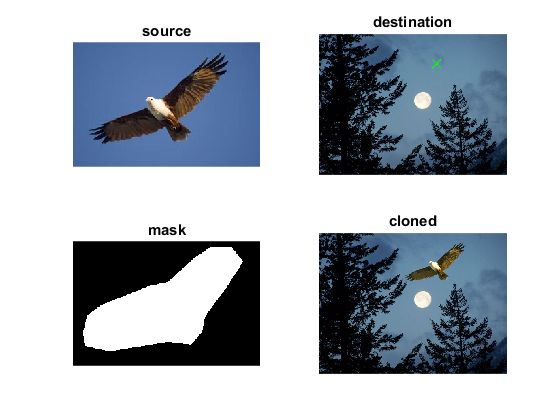ComfyUI Extension: seamless-clone-comfyui
Seamless Clone for ComfyUI
Custom Nodes (1)
README
ComfyUI Seamless Clone Node

A custom node for ComfyUI that implements OpenCV's seamless cloning functionality, allowing you to blend images naturally using Poisson blending techniques.
Features
-
Seamless image blending using OpenCV's
-
Three blending modes:
-
NORMAL_CLONE: Standard seamless
-
MIXED_CLONE: Mixed seamless cloning that preserves gradients
-
MONOCHROME_TRANSFER: Monochrome transfer mode
-
-
Automatic or manual center point selection
-
Compatible with ComfyUI's image processing pipeline
-
Robust handling of mismatched image proportions - automatically resizes and validates boundaries
-
Fallback blending - if seamless cloning fails, falls back to simple alpha blending
Installation
- Navigate to your ComfyUI custom nodes directory:
cd ComfyUI/custom_nodes/
- Clone this repository:
git clone https://github.com/Aksaz/comfyui-seamless-clone
- Install the required dependencies:
pip install -r requirements.txt
Usage
The node accepts the following inputs:
-
source_image: The image to be cloned (foreground)
-
destination_image: The target image (background)
-
mask_image: A binary mask defining the region to be cloned
-
blend_mode: Choose between NORMAL_CLONE, MIXED_CLONE, or MONOCHROME_TRANSFER
-
center_x: X-coordinate of the clone center (optional)
-
center_y: Y-coordinate of the clone center (optional)
Output:
cloned_image: The resulting seamlessly blended image
Important Notes
- Image Proportions: The node automatically resizes the source image and mask to match the destination image dimensions to prevent boundary errors.
- Center Point Validation: If center coordinates are provided, they are automatically clamped to valid image boundaries.
- Fallback Mode: If seamless cloning fails due to complex geometry or boundary issues, the node automatically falls back to simple alpha blending.
- Mask Validation: The mask is automatically cropped to ensure it fits within the destination image bounds.
Troubleshooting
Common Issues
-
"Mask is empty after processing": Ensure your mask contains non-zero values in the region you want to clone.
-
"No valid mask pixels found": Check that your mask image has visible content in the areas you want to clone.
-
Seamless cloning falls back to alpha blending: This is normal behavior when the geometry is too complex for seamless cloning. The result will still be a blended image, though without the advanced Poisson blending.
Best Practices
- Use masks with clear, well-defined boundaries for best results
- Ensure the source image has good contrast with the destination image
- For complex shapes, consider using the MIXED_CLONE mode which preserves gradients better
Requirements
- numpy==2.2.0
- opencv_python==4.10.0.84
- torch==2.5.1
Contributing
Contributions are welcome! Here's how to contribute:
- Fork the repository
- Create a feature branch (
git checkout -b feature/amazing-feature) - Commit your changes (
git commit -m 'Add amazing feature') - Push to the branch (
git push origin feature/amazing-feature) - Open a Pull Request
Please ensure your code follows the existing style and includes appropriate documentation updates.
License
This project is licensed under the MIT License - see the LICENSE file for details.
Credits
This node utilizes OpenCV's seamless cloning implementation based on the paper "Seamless Image Cloning and Editing" by Patrick Pérez, Michel Gangnet, and Andrew Blake.